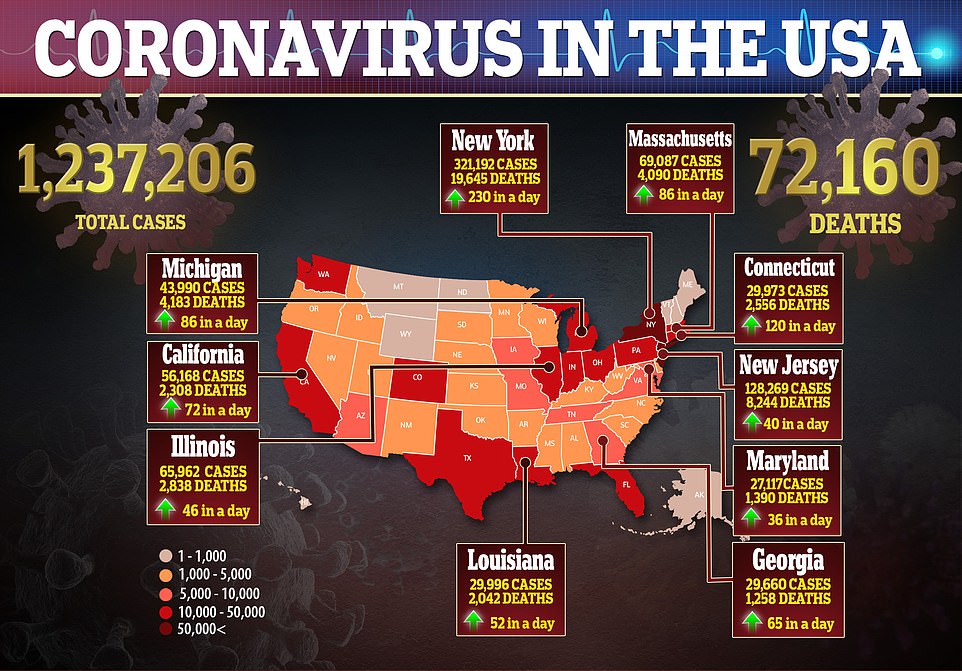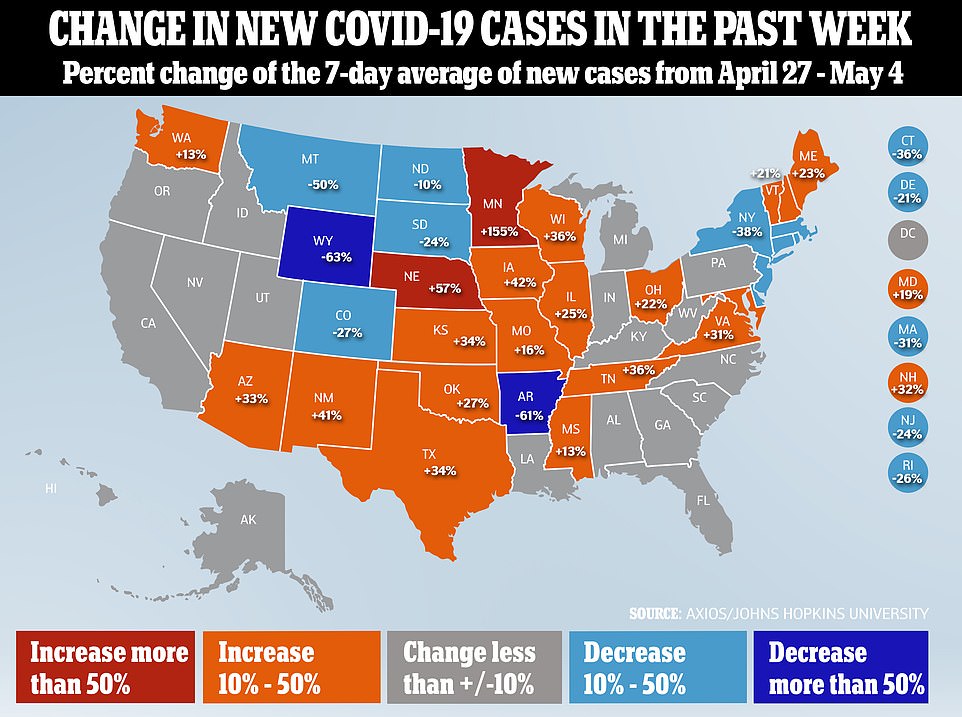Minnesota and Nebraska have seen a surge in new coronavirus cases as data shows that COVID-19 is on the rise across the United States with infection rates increasing even as states continue to lift their lockdown measures.
Data is showing that declining cases in hard-hit New York are driving the national trend downwards when more than a third of states are actually still seeing infections increase.
Despite the rising infections, the majority of states across the US have lifted lockdown restrictions or have announced plans to reopen – even as health experts warn of potential spikes in deaths.
The two Midwest states of Minnesota and Nebraska are showing alarming trends, according to data compiled by Axios comparing the seven day averages of new infections for each state over two weeks.
Minnesota, which has a total of 7,234 cases, has seen a 155 percent increase in new infections in the span of a week. With just over 6,000 cases, Nebraska has seen a 57 percent increase in new infections in a week.
Iowa, which has 10,400 infections, has seen a 42 percent increase in cases and Virginia’s infections, which are now at 20,200, have increased 31 percent.
At the other end of the scale, Arkansas and Wyoming are showing the most decline in cases.
Arkansas, for example, has seen a 61 percent decline in new cases, bringing the total to nearly 3,500.
Meanwhile, Wyoming has seen a 63 percent decline, bringing the total to nearly 600 cases.
Hard-hit New York, which has more than 321,000 cases, has seen a decrease of 38 percent in new infections.
As the majority of states lift restrictions and allow businesses to reopen, public health experts are warning that a failure to flatten the curve and drive down the infection rate in places could lead to a spike in deaths.
The experts have warned that apart from epicenter New York, data shows the rest of the US is moving in the wrong direction with new confirmed infections per day exceeding 20,000 and deaths per day are well over 1,000.
Currently, more than 72,000 people have now died from the coronavirus and there are more than 1.2 million infections across the country.
The densely packed New York area, consisting of about 20 million people, has been the hardest-hit corner of the country and accounts for at least one third of US deaths.
As of this morning the state had more than 321,000 positive cases, and the number of deaths had risen to 19,977.
When the still locked-down area is included in infection tolls, new infections in the US appear to be declining, according to an AP analysis.
It found that the five-day rolling average for new cases has decreased from 9.3 per 100,000 people three weeks ago on April 13 to 8.6 on Monday.
But subtracting the New York area from the analysis changes the story. Without it, the rate of new cases in the US increased over the same period from 6.2 per 100,000 people to 7.5.
US testing for the virus has been expanded and that has probably contributed to the increasing rate of confirmed infections.
But it doesn’t explain the entire increase, according to Dr. Zuo-Feng Zhang, a public health researcher at the University of California at Los Angeles.
‘This increase is not because of testing. It’s a real increase,’ he said.
Pockets of America far from New York City are seeing ominous trends.
Deaths in Iowa surged to a new daily high of 19 on Tuesday, and 730 workers at a single Tyson Foods pork plant tested positive.
On Monday, Shawnee County, home to Topeka, Kansas, reported a doubling of cases from last week on the same day that business restrictions began to ease.
Gallup, New Mexico, is under a strict lockdown until Thursday because of an outbreak, with guarded roadblocks to prevent travel in and out and a ban on more than two people in a vehicle.
A model from the University of Washington this week nearly doubled its projection of COVID-19 deaths in the US to around 134,000 through early August.
Dr. Christopher Murray, director of the institute that created the projections, said the increase is largely because most states are expected to ease restrictions by next week.
Without stay-at-home orders and similar measures, Murray said ‘we would have had exponential growth, much larger epidemics and deaths in staggering numbers’.
But he said cooperation is waning with cellphone location data showing people are getting out more – even before their states reopen.
An ominous forecast from a University Of Pennsylvania’s Wharton School model has predicted there could be 350,000 deaths by the end of June if all states lift stay-at-home orders and allow businesses and restaurants to reopen.
In comparison, the model predicts that nearly 160,000 deaths will occur by the end of June if people maintain social distancing but all states only partially reopen by lifting emergency declarations, stay-at-home orders and school closures.
The model’s best case scenario, which is still worse than the 100,000 fatalities President Trump has suggested, predicts the death toll will climb to 115,000 in the next two months.
This scenario accounts for people still choosing to social distance and each state maintaining the lockdown measures that were in place until April 30 before the majority of states started partially reopening.
According to the model, there could be 7.7 million infections across the country by the end of June if all states reopen, 3.2 million if states partially reopen and 2.2 million if lockdown restrictions are maintained.
In addition to death and infection predictions, the Wharton model also forecasts the economic effects of states choosing to reopen.
The model forecasts a total of 18.6 million job losses by the end of June and a 11.6 percent drop in the GDP compared to 2019 if strict lockdowns across the US are maintained.
In comparison, there could be 11.3 million job losses and a 10.7 percent drop in GDP if states only partially reopen and 500,000 job losses and a 10.1 percent GDP decline if all completely reopen.
More than 30 million Americans have filed for unemployment benefits in the past six weeks as the coronavirus pandemic caused business to close.
The official unemployment rate for April is due to be released on Friday and economists are predicting it could be as high as 20 percent.

